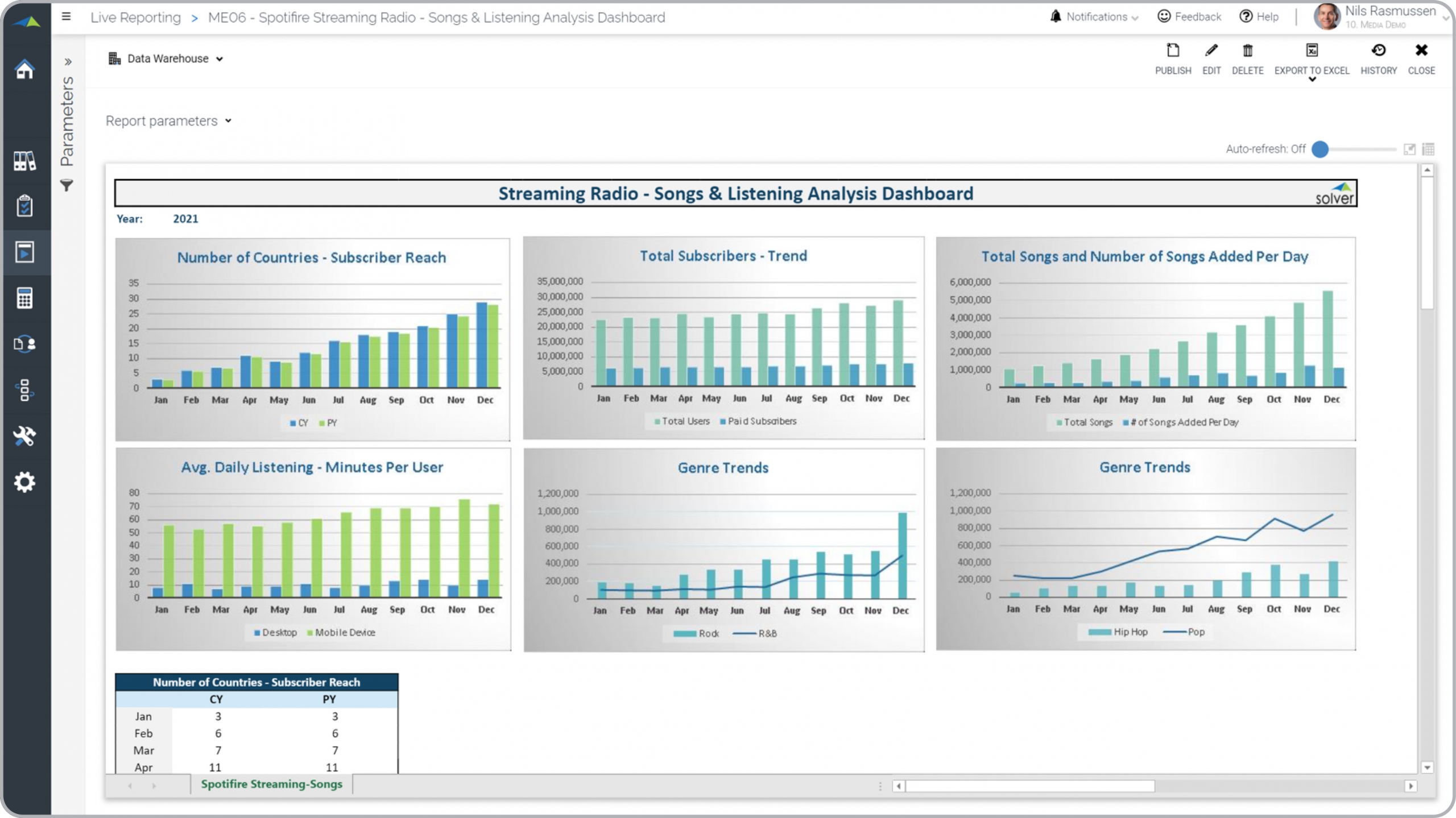Category and Listener KPI Dashboard for Media Companies
What is
a
Category and Listener KPI Dashboard
? Category and Listener KPI Dashboards are considered statistical analysis tools and are used by media executives and content managers to analyze monthly trends in user and content metrics. Some of the main functionality in this type of dashboard is that it provides monthly trend analysis from six different perspectives: 1) Current year (CY) and prior year (PY) by number of countries reached, 2) Average daily listening (minutes) by desktop and mobile device, 3) Total users versus paid subscribers, 4) Monthly listeners by genre, and 5) Total songs and number of songs added per day. You find an example of this type of dashboard below.
Purpose of
Category and Listener Dashboards Media companies use Category and Listener Dashboards to give managers a clear picture of monthly trends and seasonality as it relates to streaming users and available content. When used as part of good business practices in Subscriber Sales and Content departments, a company can improve its marketing and category strategies. It can also reduce the chances that underperforming subscriptions or categories go under the radar that otherwise would be evident looking at trend charts.
Example of a
Category and Listener Dashboard Here is an example of a Music Category and Listener Metrics Dashboard with six monthly trend charts and comparative data. [caption id="" align="alignnone" width="2560"]
 Example of a Category and Listener KPI Dashboard for Media Companies[/caption] You can find hundreds of additional examples
here
Who Uses This Type of
Dashboard
? The typical users of this type of dashboard are: Executives, Content Managers, Marketing Managers, Category Managers, Budget Managers.
Other Reports Often Used in Conjunction with
Category and Listener Dashboards Progressive Subscriber Sales and Content departments sometimes use several different Category and Listener Dashboards, along with recurring revenue forecasts, recurring revenue dashboards, churn reports, subscription reports, sales forecasts, profit & loss reports, annual budgets, financial dashboards, KPI dashboards, category dashboards and other management and control tools.
Where Does the Data for Analysis Originate From? The Actual (historical transactions) data typically comes from enterprise resource planning (ERP) systems like: Microsoft Dynamics 365 (D365) Finance, Microsoft Dynamics 365 Business Central (D365 BC), Microsoft Dynamics AX, Microsoft Dynamics NAV, Microsoft Dynamics GP, Microsoft Dynamics SL, Sage Intacct, Sage 100, Sage 300, Sage 500, Sage X3, SAP Business One, SAP ByDesign, Acumatica, Netsuite and others. In analyses where budgets or forecasts are used, the planning data most often originates from in-house Excel spreadsheet models or from professional corporate performance management (CPM/EPM) solutions.
What Tools are Typically used for Reporting, Planning and Dashboards? Examples of business software used with the data and ERPs mentioned above are:
Example of a Category and Listener KPI Dashboard for Media Companies[/caption] You can find hundreds of additional examples
here
Who Uses This Type of
Dashboard
? The typical users of this type of dashboard are: Executives, Content Managers, Marketing Managers, Category Managers, Budget Managers.
Other Reports Often Used in Conjunction with
Category and Listener Dashboards Progressive Subscriber Sales and Content departments sometimes use several different Category and Listener Dashboards, along with recurring revenue forecasts, recurring revenue dashboards, churn reports, subscription reports, sales forecasts, profit & loss reports, annual budgets, financial dashboards, KPI dashboards, category dashboards and other management and control tools.
Where Does the Data for Analysis Originate From? The Actual (historical transactions) data typically comes from enterprise resource planning (ERP) systems like: Microsoft Dynamics 365 (D365) Finance, Microsoft Dynamics 365 Business Central (D365 BC), Microsoft Dynamics AX, Microsoft Dynamics NAV, Microsoft Dynamics GP, Microsoft Dynamics SL, Sage Intacct, Sage 100, Sage 300, Sage 500, Sage X3, SAP Business One, SAP ByDesign, Acumatica, Netsuite and others. In analyses where budgets or forecasts are used, the planning data most often originates from in-house Excel spreadsheet models or from professional corporate performance management (CPM/EPM) solutions.
What Tools are Typically used for Reporting, Planning and Dashboards? Examples of business software used with the data and ERPs mentioned above are:
- Native ERP report writers and query tools
- Spreadsheets (for example Microsoft Excel)
- Corporate Performance Management (CPM) tools (for example Solver)
- Dashboards (for example Microsoft Power BI and Tableau)
Corporate Performance Management (CPM) Cloud Solutions and More Examples
July 26, 2021
TAGS:
Reporting,
Solver,
print,
report writer,
Microsoft,
template,
practice,
Acumatica,
Netsuite,
TV,
streaming,
Finance,
monthly trend,
planning,
GP,
category,
Business Central,
excel,
radio,
ax,
forecast,
Budget,
Dynamics 365,
budgeting,
Cloud,
Software,
Tableau,
SAP,
example,
media,
best,
Sage,
BC,
D365,
NAV,
Intacct,
broadcast,
online,
CPM,
report,
SL,
Management,
dynamics,
Power BI,
media dashboard,
genre,
streaming analysis,
listening,
subscriber,
streaming radio,
songs

